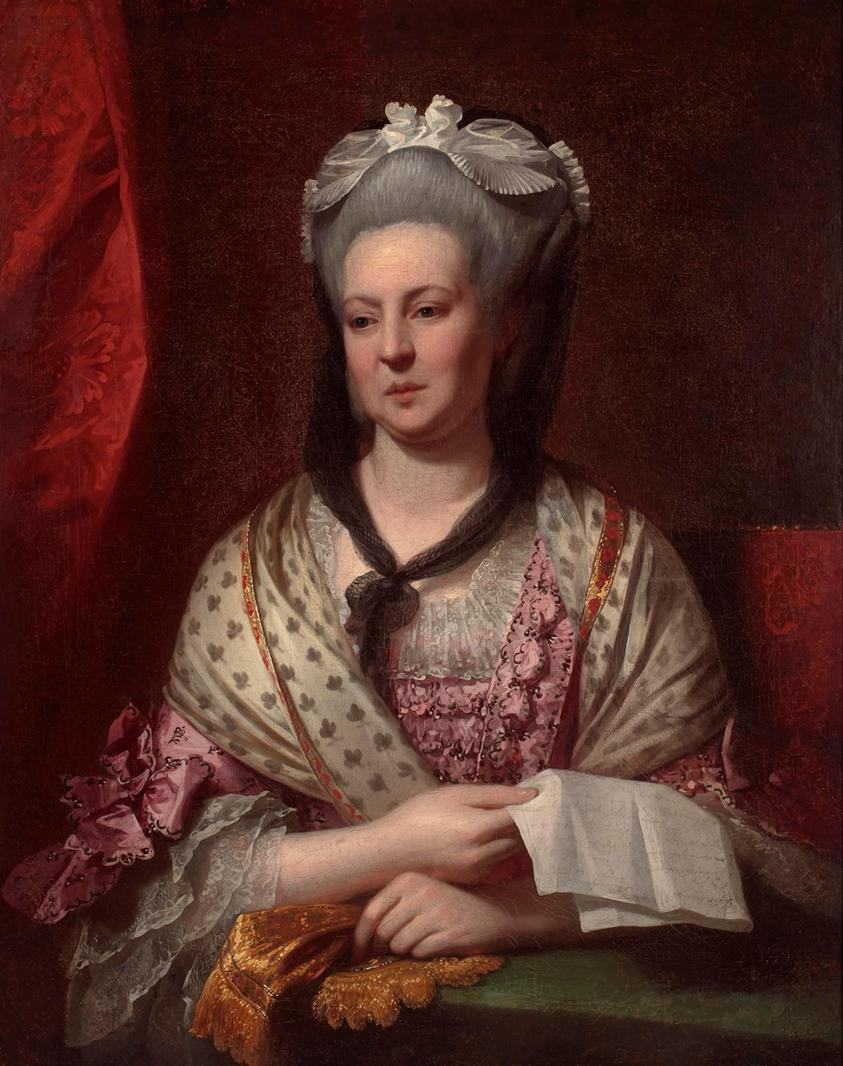
Artist:
Benjamin West
(American, 1738 - 1820)
Sitter:
Martha Harford Hare
Martha Harford Hare
Medium: Oil on canvas
Date: 1775
Dimensions:
35 1/4 × 27 5/8 in. (89.5 × 70.2 cm)
Accession number: 2005.4.1
Label Copy:
Benjamin West captured a family drama in this formal portrait of Martha Harford Hare. Elegantly dressed in layers of rich fabrics, she holds a letter with the heading "Philadelphia, 1775." Her son, Robert Hare, has written to inform her that as a result of his recent courtship and marriage, he will not be returning to England. In reply, Martha Hare commissioned this portrait and had it sent to her son. Her opinion of her son’s nuptials is conveyed by West through the sitter’s stern expression, black scarf and the inclusion of the letter.
West was born near Philadelphia, where he painted portraits before moving to New York and later to Europe. West settled permanently in England where he became known for his images of historical, religious and mythological subjects. He was among the very first American-born artists to achieve international acclaim and was named court painter to George III in 1772. Beginning in 1792, West served as the second president of the Royal Academy in London where he influenced the development of numerous aspiring artists.
Benjamin West captured a family drama in this formal portrait of Martha Harford Hare. Elegantly dressed in layers of rich fabrics, she holds a letter with the heading "Philadelphia, 1775." Her son, Robert Hare, has written to inform her that as a result of his recent courtship and marriage, he will not be returning to England. In reply, Martha Hare commissioned this portrait and had it sent to her son. Her opinion of her son’s nuptials is conveyed by West through the sitter’s stern expression, black scarf and the inclusion of the letter.
West was born near Philadelphia, where he painted portraits before moving to New York and later to Europe. West settled permanently in England where he became known for his images of historical, religious and mythological subjects. He was among the very first American-born artists to achieve international acclaim and was named court painter to George III in 1772. Beginning in 1792, West served as the second president of the Royal Academy in London where he influenced the development of numerous aspiring artists.
Curatorial RemarksMartha Harford (1720-1786) was born in Bath, England. In 1745, she became the second wife of Richard Hare. In this portrait, she is holding a letter inscribed "Philadelphia 1775." The letter is from her son Robert Hare (1752-1811), who while on a visit to Philadelphia, met and married Margaret Willing. In response to the news that her son would not return to England, Mrs. Hare had this portrait painted and sent to him. The black scarf around her neck and stern expression suggest her displeasure with Robert's decision.
Before Benjamin West became a painter of historical, religious, and mythological subjects, he was a portrait painter. His early portraits show that he was aware of the conventions of English portraiture, which he owed to his study of prints and the work of such English painters as William Williams and John Wollaston. West executed many portraits in Pennsylvania and in 1758 went to New York in search of new sitters and higher income. After two successful years there, he left to study in Italy before traveling on to England where he settled permanently. He was one of the first American artists to win a wide reputation in Europe, exerting considerable influence as a friend and advisor to Americans studying in England, including Gilbert Stuart, Charles Willson Peale, John Singleton Copley, Ralph Earl, Rembrandt Peale, Thomas Sully, and others.
Before Benjamin West became a painter of historical, religious, and mythological subjects, he was a portrait painter. His early portraits show that he was aware of the conventions of English portraiture, which he owed to his study of prints and the work of such English painters as William Williams and John Wollaston. West executed many portraits in Pennsylvania and in 1758 went to New York in search of new sitters and higher income. After two successful years there, he left to study in Italy before traveling on to England where he settled permanently. He was one of the first American artists to win a wide reputation in Europe, exerting considerable influence as a friend and advisor to Americans studying in England, including Gilbert Stuart, Charles Willson Peale, John Singleton Copley, Ralph Earl, Rembrandt Peale, Thomas Sully, and others.